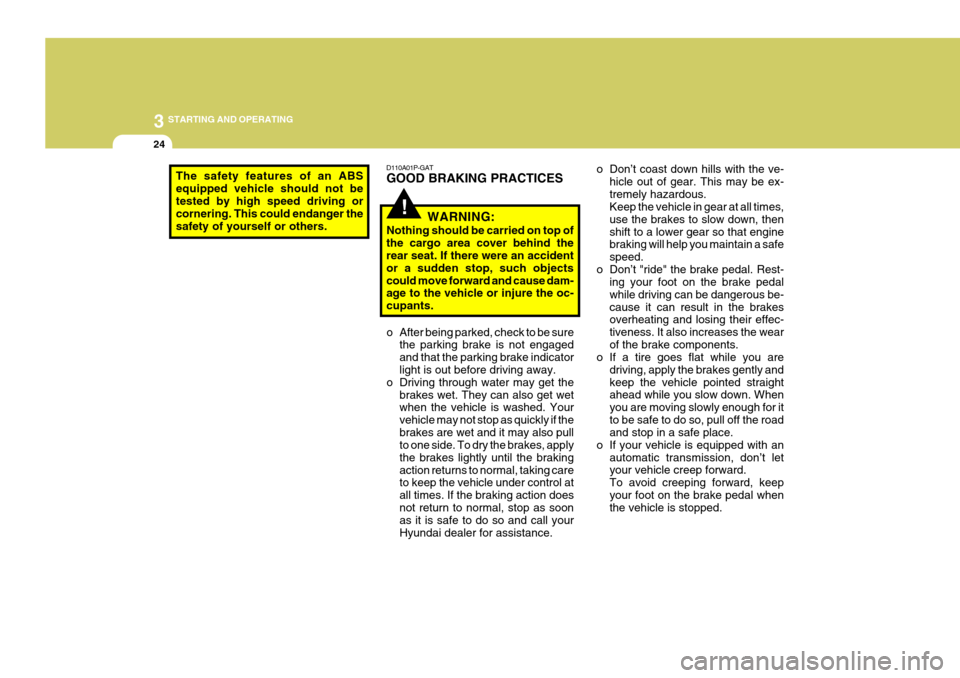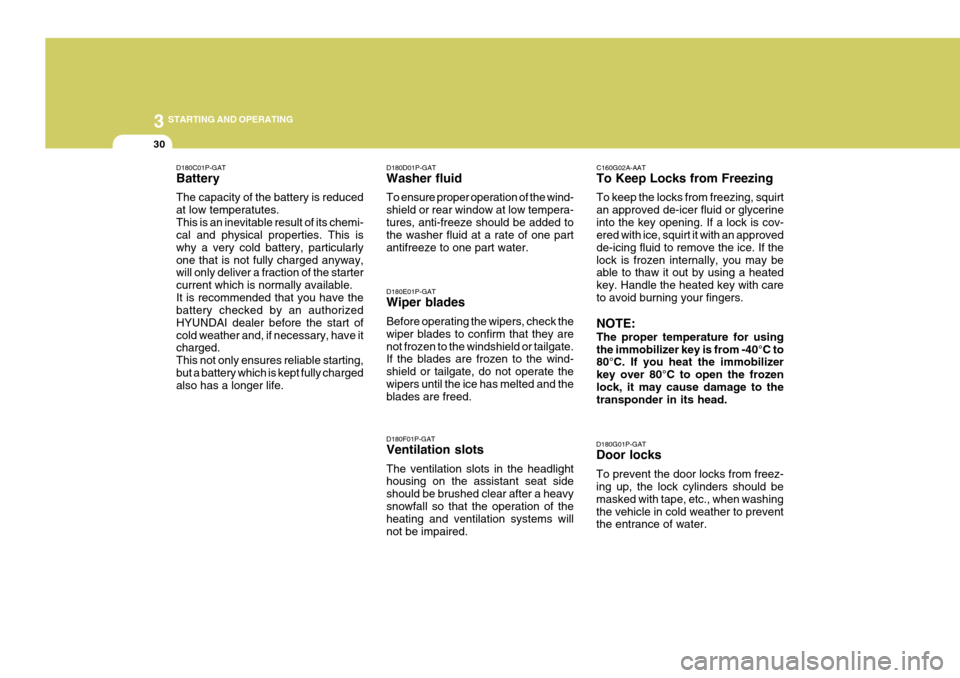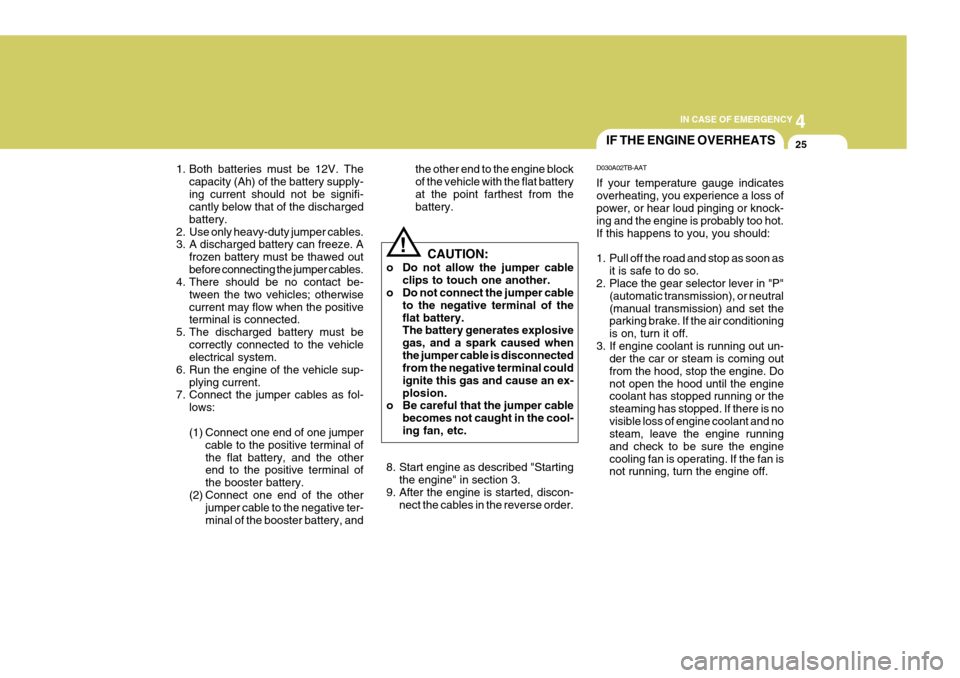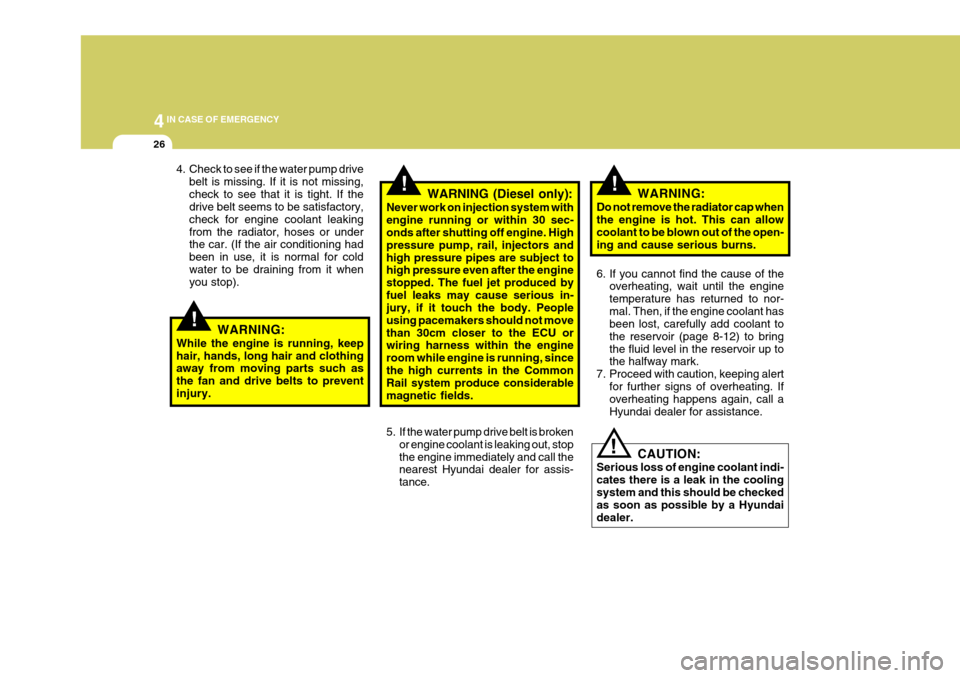2007 Hyundai H-1 (Grand Starex) heating
[x] Cancel search: heatingPage 166 of 284

3 STARTING AND OPERATING
24
The safety features of an ABS equipped vehicle should not be tested by high speed driving or cornering. This could endanger thesafety of yourself or others.
!
D110A01P-GAT GOOD BRAKING PRACTICES
WARNING:
Nothing should be carried on top of the cargo area cover behind the rear seat. If there were an accident or a sudden stop, such objectscould move forward and cause dam- age to the vehicle or injure the oc- cupants.
o After being parked, check to be sure the parking brake is not engagedand that the parking brake indicator light is out before driving away.
o Driving through water may get the brakes wet. They can also get wetwhen the vehicle is washed. Your vehicle may not stop as quickly if thebrakes are wet and it may also pull to one side. To dry the brakes, apply the brakes lightly until the brakingaction returns to normal, taking care to keep the vehicle under control at all times. If the braking action doesnot return to normal, stop as soon as it is safe to do so and call your Hyundai dealer for assistance. o Don’t coast down hills with the ve-
hicle out of gear. This may be ex-tremely hazardous. Keep the vehicle in gear at all times, use the brakes to slow down, thenshift to a lower gear so that engine braking will help you maintain a safe speed.
o Don’t "ride" the brake pedal. Rest- ing your foot on the brake pedalwhile driving can be dangerous be-cause it can result in the brakes overheating and losing their effec- tiveness. It also increases the wearof the brake components.
o If a tire goes flat while you are
driving, apply the brakes gently andkeep the vehicle pointed straight ahead while you slow down. When you are moving slowly enough for itto be safe to do so, pull off the road and stop in a safe place.
o If your vehicle is equipped with an automatic transmission, don’t letyour vehicle creep forward. To avoid creeping forward, keepyour foot on the brake pedal when the vehicle is stopped.
Page 172 of 284

3 STARTING AND OPERATING
30
D180C01P-GAT Battery The capacity of the battery is reduced at low temperatutes.This is an inevitable result of its chemi- cal and physical properties. This is why a very cold battery, particularlyone that is not fully charged anyway, will only deliver a fraction of the starter current which is normally available.It is recommended that you have the battery checked by an authorized HYUNDAI dealer before the start ofcold weather and, if necessary, have it charged. This not only ensures reliable starting,but a battery which is kept fully charged also has a longer life. C160G02A-AAT To Keep Locks from Freezing To keep the locks from freezing, squirt an approved de-icer fluid or glycerineinto the key opening. If a lock is cov- ered with ice, squirt it with an approved de-icing fluid to remove the ice. If thelock is frozen internally, you may be able to thaw it out by using a heated key. Handle the heated key with careto avoid burning your fingers. NOTE: The proper temperature for using the immobilizer key is from -40°C to 80°C. If you heat the immobilizer key over 80°C to open the frozenlock, it may cause damage to the transponder in its head.
D180G01P-GAT Door locks To prevent the door locks from freez- ing up, the lock cylinders should be masked with tape, etc., when washingthe vehicle in cold weather to prevent the entrance of water.
D180D01P-GAT Washer fluid To ensure proper operation of the wind- shield or rear window at low tempera-tures, anti-freeze should be added to the washer fluid at a rate of one part antifreeze to one part water. D180E01P-GAT Wiper blades Before operating the wipers, check the wiper blades to confirm that they arenot frozen to the windshield or tailgate. If the blades are frozen to the wind- shield or tailgate, do not operate thewipers until the ice has melted and the blades are freed. D180F01P-GAT Ventilation slots The ventilation slots in the headlight housing on the assistant seat side should be brushed clear after a heavysnowfall so that the operation of the heating and ventilation systems will not be impaired.
Page 197 of 284

4
CORROSION PREVENTION AND APPEARANCE CARE
21
4
IN CASE OF EMERGENCY
21BLEEDING THE FUEL SYSTEM
CAUTION:
If overheating should occur when towing, (temperature gauge reads near red zone), taking the followingaction may reduce or eliminate the problem.
1. Turn off the air conditioner.
2. Reduce highway speed.
3. Select a lower gear when going uphill.
4. While in stop and go traffic, place
the gear selection in park or neu-tral and idle the engine at a higher speed.
! E090A01P-GAT (Diesel Motor) The fuel system should be bled to remove air as described in the illustra- tion if the fuel supply is exhaustedduring travel, when the fuel filter is replaced, or if the vehicle is not used for a long time.
1. Loosen the air plug at the top of the
fuel filter. E090A01P
13.Avoid holding the brake pedal down
too long or too frequently. This could cause the brakes to overheat, re- sulting in reduced braking efficiency.
14.When going down a hill, shift into a
lower gear and use the engine brak-ing effect. When ascending a long grade, downshift the transmissionto a lower gear and reduce speed to reduce chances of engine over- loading and/or overheating.
15.If you have to stop while going uphill, do not hold the vehicle inplace by pressing on the accelera-tor. This can cause the automatic transmission to overheat. Use the parking brake or footbrake.
NOTE: When towing, check transmission fluid more frequently.
Page 201 of 284

4
CORROSION PREVENTION AND APPEARANCE CARE
25
4
IN CASE OF EMERGENCY
25IF THE ENGINE OVERHEATS
CAUTION:
o Do not allow the jumper cable clips to touch one another.
o Do not connect the jumper cable
to the negative terminal of the flat battery. The battery generates explosive gas, and a spark caused whenthe jumper cable is disconnected from the negative terminal could ignite this gas and cause an ex-plosion.
o Be careful that the jumper cable
becomes not caught in the cool-ing fan, etc.
! D030A02TB-AAT If your temperature gauge indicates overheating, you experience a loss of power, or hear loud pinging or knock- ing and the engine is probably too hot.If this happens to you, you should:
1. Pull off the road and stop as soon as
it is safe to do so.
2. Place the gear selector lever in "P"
(automatic transmission), or neutral (manual transmission) and set the parking brake. If the air conditioning is on, turn it off.
3. If engine coolant is running out un- der the car or steam is coming outfrom the hood, stop the engine. Donot open the hood until the engine coolant has stopped running or the steaming has stopped. If there is novisible loss of engine coolant and no steam, leave the engine running and check to be sure the enginecooling fan is operating. If the fan is not running, turn the engine off.
the other end to the engine block of the vehicle with the flat batteryat the point farthest from the battery.
8. Start engine as described "Starting the engine" in section 3.
9. After the engine is started, discon- nect the cables in the reverse order.
1. Both batteries must be 12V. The
capacity (Ah) of the battery supply- ing current should not be signifi- cantly below that of the discharged battery.
2. Use only heavy-duty jumper cables.
3. A discharged battery can freeze. A
frozen battery must be thawed out before connecting the jumper cables.
4. There should be no contact be-
tween the two vehicles; otherwisecurrent may flow when the positive terminal is connected.
5. The discharged battery must be correctly connected to the vehicleelectrical system.
6. Run the engine of the vehicle sup- plying current.
7. Connect the jumper cables as fol-
lows:
(1) Connect one end of one jumper cable to the positive terminal of the flat battery, and the other end to the positive terminal of the booster battery.
(2) Connect one end of the other jumper cable to the negative ter-minal of the booster battery, and
Page 202 of 284

44IN CASE OF EMERGENCY
26
4. Check to see if the water pump drivebelt is missing. If it is not missing, check to see that it is tight. If the drive belt seems to be satisfactory, check for engine coolant leakingfrom the radiator, hoses or under the car. (If the air conditioning had been in use, it is normal for coldwater to be draining from it when you stop).
!WARNING:
While the engine is running, keep hair, hands, long hair and clothing away from moving parts such as the fan and drive belts to preventinjury.
!WARNING (Diesel only):
Never work on injection system with engine running or within 30 sec- onds after shutting off engine. High pressure pump, rail, injectors andhigh pressure pipes are subject to high pressure even after the engine stopped. The fuel jet produced byfuel leaks may cause serious in- jury, if it touch the body. People using pacemakers should not movethan 30cm closer to the ECU or wiring harness within the engine room while engine is running, sincethe high currents in the Common Rail system produce considerable magnetic fields.
5. If the water pump drive belt is broken or engine coolant is leaking out, stop the engine immediately and call the nearest Hyundai dealer for assis- tance.!WARNING:
Do not remove the radiator cap when the engine is hot. This can allow coolant to be blown out of the open- ing and cause serious burns.
6. If you cannot find the cause of the overheating, wait until the engine temperature has returned to nor-mal. Then, if the engine coolant has been lost, carefully add coolant to the reservoir (page 8-12) to bringthe fluid level in the reservoir up to the halfway mark.
7. Proceed with caution, keeping alert for further signs of overheating. Ifoverheating happens again, call a Hyundai dealer for assistance.
CAUTION:
Serious loss of engine coolant indi-cates there is a leak in the coolingsystem and this should be checked as soon as possible by a Hyundai dealer.
!
Page 278 of 284

10INDEX
2
A ADJUSTABLE FRONT SEATS .................................. 1-32
AIR CONDITIONING CARE .......................................8-15
AIR CONDITI ONING SYSTEM .................................. 2-44
ALTIMETER ............................................................... 2-18
ANTENNA .................................................................. 2-73
ANTI-LOCK BRAKE SYSTEM ................................... 3-24
APPEARANCE CARE ................................................. 5-2
ASHTRAY .................................................................. 2-36
AUDIO FAULT CODE ................................................. 2-70
AUDIO SYSTEM Cassette Tape Player Operation (H240, H280)...................................................................... 2-54, 2-65
Compact Disc Player Operation (H260, H280) ...................................................................... 2-59, 2-67
Stereo Radio Operation (H240, H260, H280)
............................................................ 2-51, 2-56, 2-62
AUTOMATIC TRANSMISSION ..................................3-10
AUTOMATIC TRANSMISSION FLUID .......................8-18
AUXILIARY SEAT ...................................................... 1-38BBATTERY
................................................................... 8-13
BEFORE STARTING THE ENGINE ............................ 3-3
BI-LEVEL HEATING ................................................... 2-42
BLEEDING THE FUEL SYSTEM ............................. 4-21
BRAKE FLUID ............................................................ 8-17
BRAKE PEDAL .......................................................... 3-22
BRAKE SYSTEM ....................................................... 3-20
BULB WATTAGE ....................................................... 4-38
CCARE OF CASSETTE TAPES .................................. 2-72
CARE OF DI SC .......................................................... 2-71
CARRYING CHILDREN .............................................. 1-16
CATALYTIC CONVERTER ....... ................................... 7-3
CENTRAL DOOR LOCKS ..... .....................................1-15
CHANGING A FLAT TIRE ........................................... 4-7
CHANGING AND REPLACING FUSES .....................4-27
CHANGING THE CLIMATE CONTROL AIR FILTER . 8-16
CHECKING THE DRIVE BELTS ................................ 8-24
CHECKING THE FREEPLAY .....................................8-23
CHILD PROTECTION SLIDE DOOR ..........................1-16
CHILD RESTRAINT SYSTEM .................................... 1-46
CIGARETTE LIGHTER ............................................... 2-27
CLIMATE CONTROL AIR FILTER ............................. 2-47
CLUTCH FLUID .......................................................... 8-18
Page 279 of 284

10
INDEX
3
D DAY/NIGHT INSIDE REARVIEW MIRROR ................2-34
DEFROSTING/DEFOGGING ......................................2-43
DIGITAL CLOCK ........................................................ 2-37
DOOR LOCKS ............................................................ 1-13
DRINK HOLDER ......................................................... 2-35
DRIVING FOR ECONOMY .........................................3-26
DRIVING WITH ELECTRONIC DUAL-RANGE AUTOMATIC TRANSMISSION ...............................3-14
EEMISSION CONTROL SYSTEM ................................. 7-2
ENGINE ....................................................................... 9-3
ENGINE COMPARTMENT . ......................................... 8-2
ENGINE COOLANT .................................................... 8-10
ENGINE COOLANT TEMPERATURE GAUGE ..........2-12
ENGINE EXHAUST CAN BE DANGEROUS! ............. 3-2
ENGINE NUMBER ...................................................... 1-6
ENGINE OIL ................................................................ 8-7ENGINE RPM ADJUSTMENT KNOB ........................2-24
EXPLANATION OF SCHEDULED
MAINTENANCE ITEMS .............. ...........................6-12
FFOUR-WHEEL DRIVE (4WD) .....................................3-16
FRONT DOOR EDGE WARNING LIGHT ................... 2-25
FRONT DOOR WINDOW GLASS ..............................1-28FRONT FOG LI
GHT SWITCH .................................... 2-25
FRONT/REAR WINDOW DEFROSTER SWITCH ......2-26
FUEL GAUGE ............................................................ 2-12
FUEL RECOMMENDATIONS ...................................... 1-2
FUEL TANK CAPACITY .............................................. 9-2
FUSE PANEL DESC RIPTION .................................... 4-40
GGENERAL CHECKS .................................................... 8-6
GOOD BRAKING PRAC TICE .................................... 3-23
HHAZARD WARNING SYSTEM ................................... 2-26
HEADLIGHT AIMING ADJUSTMENT ........................ 4-29
HEADLIGHT LEVELING DEVICE SYSTEM ..............2-23
HEADREST ................................................................ 1-39
HEATING AND COOLING CONTROL ........................2-38
HEATING CONTROLS ............................................... 2-42
HEIGHT ADJUSTABLE FRONT SEAT SHOULDER BELT ....................................................................... 1-43
HIGH-MOUNTED REAR STOP LIGHT .......................2-25
HOLD OPEN LOCK SYSTEM .................................... 1-14
HOOD RELEASE ....................................................... 1-25
HORN ......................................................................... 2-37